| Listing 1 - 10 of 14 | << page >> |
Sort by
|
Book
Year: 2006 Publisher: Zürich Germann
Abstract | Keywords | Export | Availability | Bookmark
 Loading...
Loading...Choose an application
- Reference Manager
- EndNote
- RefWorks (Direct export to RefWorks)
Art --- graphs --- photographs
Book
Year: 2006 Publisher: Zürich Germann
Abstract | Keywords | Export | Availability | Bookmark
 Loading...
Loading...Choose an application
- Reference Manager
- EndNote
- RefWorks (Direct export to RefWorks)
Art --- graphs --- photographs
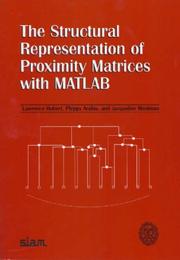
ISBN: 0898716071 Year: 2006 Publisher: Philadelphia, Pa. : Alexandria, Va. : Society for Industrial and Applied Mathematics ; American Statistical Association,
Abstract | Keywords | Export | Availability | Bookmark
 Loading...
Loading...Choose an application
- Reference Manager
- EndNote
- RefWorks (Direct export to RefWorks)
The Structural Representation of Proximity Matrices with MATLAB presents and demonstrates the use of functions within a MATLAB computational environment, affecting various structural representations for the proximity information that is assumed to be available on a set of objects. The representations included in the book have been developed primarily in the behavioral sciences and applied statistical literature, although interest in these topics now extends more widely to such fields as bioinformatics and chemometrics. This book is divided into three main sections, each based on the general class of representations being discussed. Part I develops linear and circular unidimensional and multidimensional scaling using the city-block metric as the major representational device. Part II discusses characterizations based on various graph-theoretic tree structures, specifically those referred to as ultrametrics and additive trees. Part III uses representations defined solely by order properties, particularly emphasizing what are called (strongly) anti-Robinson forms.
Functions. --- Proximity matrices. --- Representations of graphs. --- MATLAB.
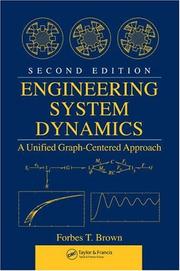
ISBN: 0849396484 Year: 2006 Publisher: CRC
Abstract | Keywords | Export | Availability | Bookmark
 Loading...
Loading...Choose an application
- Reference Manager
- EndNote
- RefWorks (Direct export to RefWorks)
Bond graphs --- Dynamics --- Engineering models --- Systems engineering
Book
ISBN: 0821838253 Year: 2006 Publisher: Providence, R.I. American Mathematical Society
Abstract | Keywords | Export | Availability | Bookmark
 Loading...
Loading...Choose an application
- Reference Manager
- EndNote
- RefWorks (Direct export to RefWorks)
Discrete mathematics --- 51 <082.1> --- Mathematics--Series --- Graph coloring --- Ramsey theory --- Random graphs. --- Coloriage de graphes --- Ramsey, Théorie de --- Graphes aléatoires --- Random graphs --- Coloring of graphs --- Graph theory --- Graphs, Random --- Combinatorial analysis --- Coloriage de graphes. --- Ramsey, Théorie de. --- Graphes aléatoires.
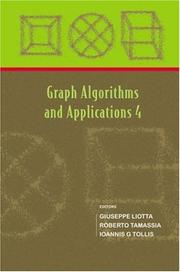
ISBN: 1281924679 9786611924676 9812773290 9789812773296 9789812568441 9789812773296 9812568441 9781281924674 Year: 2006 Publisher: Singapore ; Hackensack, N.J. : World Scientific,
Abstract | Keywords | Export | Availability | Bookmark
 Loading...
Loading...Choose an application
- Reference Manager
- EndNote
- RefWorks (Direct export to RefWorks)
This book contains Volume 7 of the Journal of Graph Algorithms and Applications (JGAA). JGAA is a peer-reviewed scientific journal devoted to the publication of high-quality research papers on the analysis, design, implementation, and applications of graph algorithms. Areas of interest include computational biology, computational geometry, computer graphics, computer-aided design, computer and interconnection networks, constraint systems, databases, graph drawing, graph embedding and layout, knowledge representation, multimedia, software engineering, telecommunications ne
Graph algorithms. --- Graph theory. --- Graph theory --- Graphs, Theory of --- Theory of graphs --- Combinatorial analysis --- Topology --- Computer algorithms --- Extremal problems
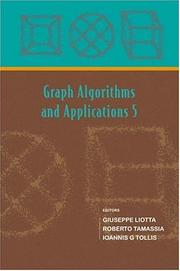
ISBN: 1281924660 9786611924669 9812773282 9789812773289 9789812568458 9789812773289 981256845X 9781281924667 Year: 2006 Publisher: Singapore ; Hackensack, N.J. : World Scientific,
Abstract | Keywords | Export | Availability | Bookmark
 Loading...
Loading...Choose an application
- Reference Manager
- EndNote
- RefWorks (Direct export to RefWorks)
This book contains Volume 8 of the Journal of Graph Algorithms and Applications (JGAA). JGAA is a peer-reviewed scientific journal devoted to the publication of high-quality research papers on the analysis, design, implementation, and applications of graph algorithms. Areas of interest include computational biology, computational geometry, computer graphics, computer-aided design, computer and interconnection networks, constraint systems, databases, graph drawing, graph embedding and layout, knowledge representation, multimedia, software engineering, telecommunications ne
Graph algorithms. --- Graph theory. --- Graph theory --- Graphs, Theory of --- Theory of graphs --- Combinatorial analysis --- Topology --- Computer algorithms --- Extremal problems

ISBN: 9780521853866 0521853869 9780511755149 9780521136563 0521136563 9780511246708 0511246706 0511245300 9780511245305 051124455X 9780511244551 0511246013 9780511246012 0511755147 1139931288 1107165644 1280703393 9786610703395 0511318731 Year: 2006 Volume: 105 Publisher: Cambridge Cambridge University Press
Abstract | Keywords | Export | Availability | Bookmark
 Loading...
Loading...Choose an application
- Reference Manager
- EndNote
- RefWorks (Direct export to RefWorks)
Additive combinatorics is the theory of counting additive structures in sets. This theory has seen exciting developments and dramatic changes in direction in recent years thanks to its connections with areas such as number theory, ergodic theory and graph theory. This graduate-level 2006 text will allow students and researchers easy entry into this fascinating field. Here, the authors bring together in a self-contained and systematic manner the many different tools and ideas that are used in the modern theory, presenting them in an accessible, coherent, and intuitively clear manner, and providing immediate applications to problems in additive combinatorics. The power of these tools is well demonstrated in the presentation of recent advances such as Szemerédi's theorem on arithmetic progressions, the Kakeya conjecture and Erdos distance problems, and the developing field of sum-product estimates. The text is supplemented by a large number of exercises and new results.
Additive combinatorics --- Additive combinatorics. --- Combinatorial analysis --- Analyse combinatoire --- Combinatorial analysis. --- Graph theory. --- Graph theory --- Graphs, Theory of --- Theory of graphs --- Topology --- Combinatorics --- Algebra --- Mathematical analysis --- Extremal problems

ISBN: 158488505X 9781584885054 Year: 2006 Publisher: Boca Raton: Chapman & Hall/CRC,
Abstract | Keywords | Export | Availability | Bookmark
 Loading...
Loading...Choose an application
- Reference Manager
- EndNote
- RefWorks (Direct export to RefWorks)
Discrete mathematics --- Graph theory --- -519.17 --- 519.1 --- 511.5 --- Graphs, Theory of --- Theory of graphs --- Combinatorial analysis --- Topology --- Graph theory. Trees --- Combinatorics. Graph theory --- Extremal problems --- 519.1 Combinatorics. Graph theory --- 519.17 Graph theory. Trees --- 519.17
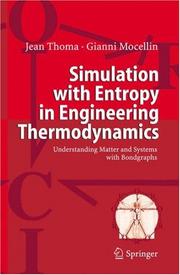
ISBN: 128085295X 9786610852956 3540328513 3540327983 3642069339 Year: 2006 Publisher: Berlin : Springer-Verlag,
Abstract | Keywords | Export | Availability | Bookmark
 Loading...
Loading...Choose an application
- Reference Manager
- EndNote
- RefWorks (Direct export to RefWorks)
Students, academics and researchers will find this book an invaluable contribution to the understanding of thermodynamics. In this new treatment of the subject, the authors focus on the principles of thermodynamic variables and the practical simulation of thermodynamic systems, and endeavour to show how simple thermodynamics really is by applying two innovations: The use of entropy as thermal charge and not as the incomprehensible Clausius integral (an idea which applies only in special cases); The use of Bond Graphs to represent relations among variables. This tool from control and systems engineering has been treated extensively in other publications by Springer, including two books by Prof. Thoma, and is succinctly explained here in an appendix. The book opens with thermodynamics as universal science and with entropy as carrier of thermal power, and goes on to consider the effects of friction, including the Carnot cycle. Next, it treats systems with variable mass and variable mass flow and extends the concepts to chemical reactions and osmosis. Finally, descending by some 20 orders of magnitude, it considers single atoms and degrees of freedom of atoms, with statistical aspects of information theory. There are also sections on biology (written in collaboration with Prof. Henri Atlan of Paris and Jerusalem) and on earth science (global warming). A modern approach with a strong emphasis on interdisciplinary engineering, this book offers a unique view of modern complex systems engineering and its ramifications, and contributes to the advance of pluridisciplinarity among scientists. The Authors Prof. Jean U. Thoma: Ph. D. in Physics, Professor of Mechanical Engineering. Originally a physicist who journeyed from hydrostatic engineering to biology through Bond Graphing and author of many books and publications on these subjects. Dr. Gianni Mocellin, Civil Engineer, Master in Business Administration, Master in Artificial Intelligence, Ph. D. in Economics, user of Bond Graphs, a pluridisciplinarian in the true sense and an accomplished practitioner in psychology, robotics and expert systems.
Thermodynamics. --- Bond graphs. --- Graph theory --- System analysis --- Chemistry, Physical and theoretical --- Dynamics --- Mechanics --- Physics --- Heat --- Heat-engines --- Quantum theory --- Mechanics, applied. --- Theoretical and Applied Mechanics. --- Applied mechanics --- Engineering, Mechanical --- Engineering mathematics --- Mechanics. --- Mechanics, Applied. --- Classical mechanics --- Newtonian mechanics
| Listing 1 - 10 of 14 | << page >> |
Sort by
|

 Search
Search Feedback
Feedback About UniCat
About UniCat  Help
Help News
News